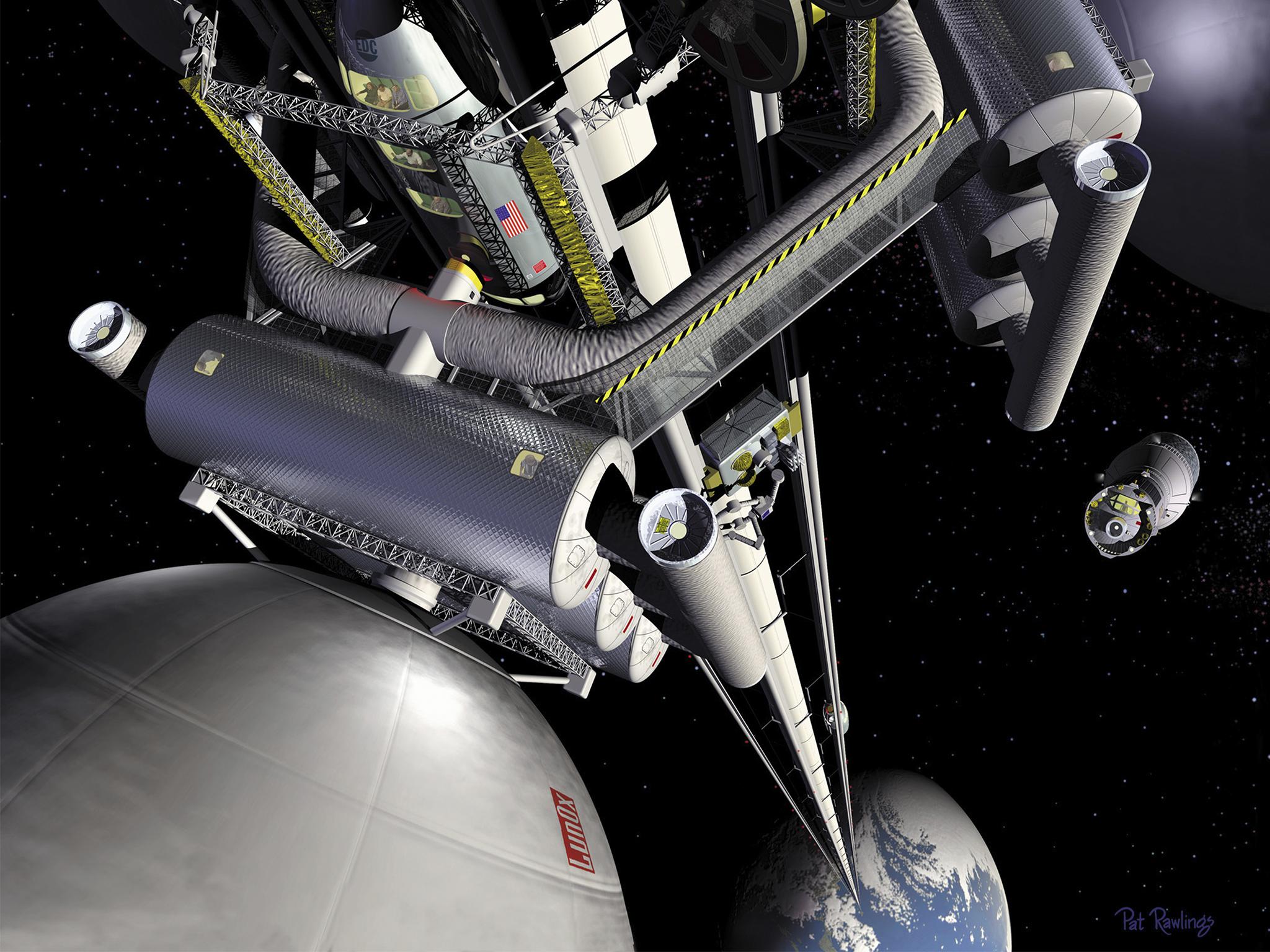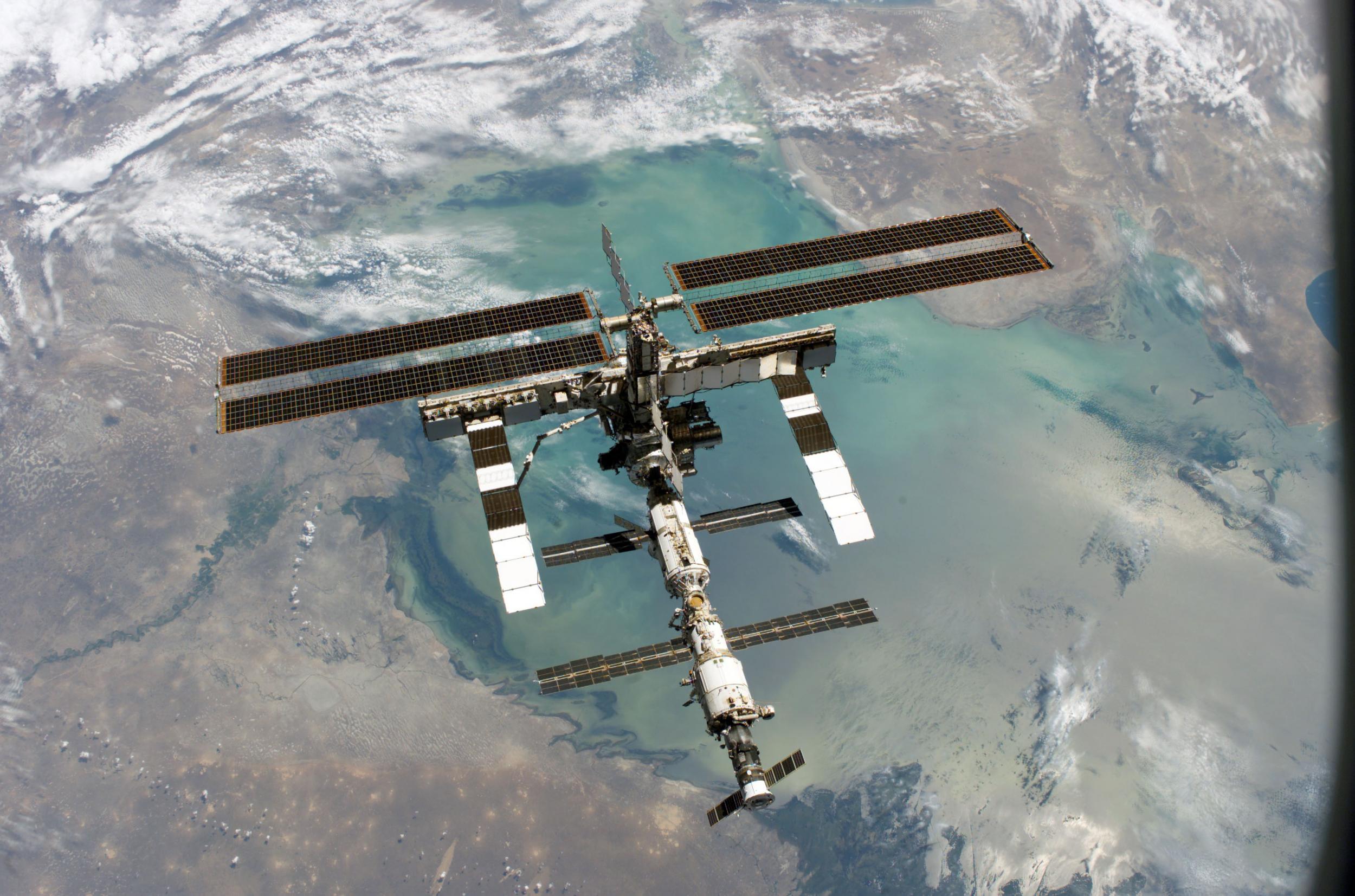Going up? How the century-old idea of a ‘space elevator’ could become reality
It was first pondered as early as 1895 and has been a science fiction trope ever since. But, Steven Cutts asks, just how close are we to constructing a ladder to the heavens?


There are some technologies that seem so well established that it’s hard to imagine how they could ever be overcome. Almost all our plans to conquer outer space are based on rockets and it’s our failure to improve them, more than anything else, that has left us confined to the surface of this planet.
But what if we didn’t really need rockets? What if engineers could build an entirely different means of gaining access to the heavens? What if, for example, we could build a simple elevator that takes off from the surface of the planet directly upwards, all the way into Earth’s orbit. Without rocket thrust, without exhaust gases and without sound.
The first suggestion that a single tower might give us access to space came from the visionary Russian space pioneer Konstantin Tsiolkovsky in 1895. Incredibly, Tsiolkovsky was studying the possibility of space colonisation 10 years before the Wright Brothers had even managed to get airborne at Kitty Hawk. Inspired by the recently constructed Eiffel Tower, he suggested that it might be possible to build a tower 35,000 kilometres (or 22,236 miles) high and use the summit as a permanent space station and gateway to the rest of the universe.
Ever since then, the space elevator has been part of the staple diet of reasonably serious science fiction writing and more than one luminary in the field has added his own, highly imaginative flourishes to its design.
It’s 125 years since Tsiolkovsky’s seminal work and the pace of scientific and engineering progress has never been faster but even now, such a structure would be difficult to build. As we enter the third decade of the 21st century, it is perhaps time to ask just how far off such a structure might be and exactly how we could build it.
Satellites orbit the Earth at a high altitude, but the time required to orbit the planet is dictated by its distance from the surface. The moon, for example, is 250,000 miles away and takes a month to travel around the world once. In contrast, the International Space Station is only about 250 miles away and whizzes around once every 90 minutes. Somewhere in between, there must be a height where a satellite takes exactly one day to orbit the Earth. This is known as geostationary orbit; the point at which a satellite orbits at the same speed that Earth is turning, making it appear to people on the ground that it stays in the same place in the sky. That distance is relatively easy to calculate: 22,236 miles above the equator. This is also the point at which most of our television satellites are placed so antennas on the ground can be pointed permanently at the same position in the sky.
So, how do we actually build the thing? Most authorities envisage the assembly of a huge space station at geostationary orbit. The engineers on board then begin to assemble a cable from the top down that must at least touch the Earth’s surface. Needless to say, such a cable, which is both long and strong enough for the task, is yet to have been invented. The cable would then be fixed to a concrete foundation on the equator. The location is an absolute requirement; by implication, a space elevator could never be built in Europe or the United States.

Further attachments could then be deployed from Earth, carried upwards by electrically powered vehicles capable of climbing the initial cable, rather than rockets. Over a period of months, a vertical train track could be constructed from the Earth to the station; essentially forming a ladder into space.
The cost of travelling into space will now fall by more than 99 per cent. Equipment, supplies and space colonists can arrive at a high Earth orbit and literally step off the space station and into zero gravity. Trips to the moon or Mars are now relatively simple since the energy interval between the planets and geostationary orbit is much smaller than that with Cape Canaveral. Rockets are old hat, a giant beanstalk will set us free and the rest of the universe will soon beckon.
So, why aren’t we building one? First of all, you have to consider the design. Old Konstantin imagined a tower that would – in effect – be loaded in compression and require a solid material, probably some kind of super concrete. More modern concepts involve a second “dead weight” that would be flown above the main space station. This design requires an even longer cable that extends from the Earth to the station and then beyond in order to keep the cable in tension.
With such a design, it’s relatively easy to calculate the tensile forces involved and – as you can imagine – they are immense. Much, much greater than any existing material could possibly tolerate. Any attempt to really build a space elevator is critically dependent on the development of entirely new materials that can both withstand the stresses involved and lend themselves to manufacture on an industrial scale.

Several science fiction writers have described the construction of a space elevator, most notably the late, great Arthur C Clarke in 1979’s The Fountains Of Paradise. His imaginary super-strong material breakthrough was a linear diamond. Incredibly, some sort of diamond-like material is still the front runner for this task.
As you may just remember from secondary school science, a diamond is the hardest structure known to man. The bonds between the carbon atoms are about as strong as they get and the only thing that can cut a diamond is another diamond.
Rockets are old hat, a giant beanstalk will set us free and the rest of the universe will soon beckon
The 1990s saw the emergence of carbon nanotubes, which sparked a renewed interest in the space elevator concept. Engineers began to make more elaborate designs, some of them suggesting that the cable should be tapered, being largest close to the space station and thinner as it left the Earth. It has been suggested that the base camp should be a vast floating structure in the Pacific, far from civilisation and at much lower risk of a lightning strike than a system built in Africa. People have even drafted plans for the design of the train-like vehicles that would ascend the cable, usually referred to as climbers.
Some authors have expressed concern about space debris, arguing that even minor pieces of junk might hit the cable at fantastic speeds and destroy the entire structure. A satellite in low Earth orbit is flying at five miles per second and an individual nut or bolt could have the impact force of a small bomb at the time of collision. If the elevator is to function for the best part of a century, then some sort of impact seems almost inevitable.

In 2019, the International Academy of Astronautics published a paper suggesting that a space elevator is feasible, although again their concept is critically dependent on the manufacture of macro-scale single-crystal graphene, another absolutely amazing modern material that might just change everything but is largely blue-sky thinking for the time being. All of the engineering studies done so far assume that material technologists will ultimately deliver the materials we need, but this won’t necessarily happen.
How then could we proceed? One way to achieve an amazing breakthrough is to start small and advance gradually. In fact, several space missions have attempted to release a cable from an orbiting satellite over a distance of many miles. During the 1990s, the Italian Space Agency attempted to release a satellite on a 10-mile cable from the back of an American space shuttle. All seemed to be going well until the wire snapped, probably due to an induced electrical signal in its core. More recently, a Japanese group attempted to transfer a mini climber from one cube-shaped satellite to another using a relatively short cable.
Another, more realistic approach is to build a space elevator on Mars. The Red Planet has about 40 per cent of the Earth’s gravity and the technical challenges involved are trivial in comparison to building one on Earth. I say trivial… the project would, of course, require the establishment of massive space infrastructure and a substantial population of space navies and vacuum-friendly robots.
For the specific case of Mars, existing materials such as kevlar would be more than capable of taking on the tensile forces involved and once such a system is constructed the actual process of landing and taking off from a Mars colony becomes straightforward. Remember we already know that there is a substantial supply of water on Mars, the raw material from which rocket fuel can be easily manufactured. Needless to say, this is all very farsighted but it does put into perspective how a complex space empire might begin.
If we want to move out beyond the surface of this planet we’re going to have to do it using good old fashioned rockets. They may be costly, they may be dangerous, but they work and they are the here and the now. Like commercial nuclear fusion, the space elevator concept is a mirage that seems to recede as fast as we approach it. None of the technology needed is going to appear in the next 20 years. Even as you read these words, there are entirely rational groups in China, Japan and the United States who are actively planning to build an Earth-based space elevator before 2050. It might sound like pie in the sky, but there is more at stake here than you can possibly imagine. Whoever gets there first will own the keys to the heavens.
Join our commenting forum
Join thought-provoking conversations, follow other Independent readers and see their replies
Comments